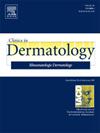Spectrum of blue nevus-like lesions, including blue nevus, pigmented epithelioid melanocytoma, and animal-type melanoma
IF 2.2
4区 医学
Q2 DERMATOLOGY
引用次数: 0
Abstract
Blue nevus-like lesions constitute a category of melanocytic lesions that are clinically identified by their blue coloration. Histologically, they exhibit two primary features: a dermal location and intense pigmentation. The latest World Health Organization classification categorizes blue melanocytic lesions into benign entities (dermal melanocytoses, blue nevus, and deep penetrating nevus), melanocytic tumors with low-to-intermediate malignant potential (pigmented epithelioid melanocytoma), and malignant lesions (blue nevus-like melanoma and melanoma arising in blue nevi). Clinically, blue nevi are enduring and stable lesions, displaying a structureless blue pigmentation clinically and dermatoscopically, with a straightforward histologic diagnosis. On the contrary, lesions with recent onset and/or rapid growth are more commonly associated with diagnoses falling within the intermediate part of the spectrum or with melanoma. These lesions often present with a blue color along with additional features such as black blotches, irregular vessels, and irregular pigmented globules. They typically emerge de novo without recognizable precursors, and they pose significant challenges for patient management. Melanoma on a blue nevus is an exceedingly rare entity with only a few cases described to date. Histologically, differentiating between lesions with intermediate malignant potential and melanoma is always challenging, necessitating a comprehensive evaluation of all morphologic findings of the lesion.
蓝痣样病变的范围,包括蓝痣、色素上皮样黑色素细胞瘤和动物型黑色素瘤。
蓝痣样病变是一类黑色素细胞病变,临床上可通过其蓝色鉴别。在组织学上,它们有两个主要特征:真皮位置和强烈的色素沉着。世界卫生组织(WHO)最新的分类方法将蓝色黑素细胞病变分为良性病变(真皮黑素细胞瘤、蓝痣和深部穿透性痣)、中低度恶性黑素细胞瘤(色素上皮样黑素细胞瘤,PEM)和恶性病变(蓝痣样黑素瘤和蓝痣中产生的黑素瘤)。在临床上,蓝痣是一种持久而稳定的病变,临床和皮肤镜检查均显示无结构的蓝色色素沉着,组织学诊断简单明了。相反,新近出现和/或生长迅速的病变则更常见于属于光谱中间部分或黑色素瘤的诊断。这些病变通常呈蓝色,并伴有其他特征,如黑色斑点、不规则血管和不规则色素球。它们通常是新出现的,没有可识别的前兆,给患者的治疗带来了很大的挑战。蓝痣上的黑色素瘤极为罕见,迄今只有少数病例被描述过。从组织学角度看,区分中等恶性潜能的病变和黑色素瘤总是很有挑战性,需要对病变的所有形态学结果进行综合评估。
本文章由计算机程序翻译,如有差异,请以英文原文为准。
求助全文
约1分钟内获得全文
求助全文
来源期刊

Clinics in dermatology
医学-皮肤病学
CiteScore
4.60
自引率
7.40%
发文量
106
审稿时长
3 days
期刊介绍:
Clinics in Dermatology brings you the most practical and comprehensive information on the treatment and care of skin disorders. Each issue features a Guest Editor and is devoted to a single timely topic relating to clinical dermatology.
Clinics in Dermatology provides information that is...
• Clinically oriented -- from evaluation to treatment, Clinics in Dermatology covers what is most relevant to you in your practice.
• Authoritative -- world-renowned experts in the field assure the high-quality and currency of each issue by reporting on their areas of expertise.
• Well-illustrated -- each issue is complete with photos, drawings and diagrams to illustrate points and demonstrate techniques.
 求助内容:
求助内容: 应助结果提醒方式:
应助结果提醒方式:


